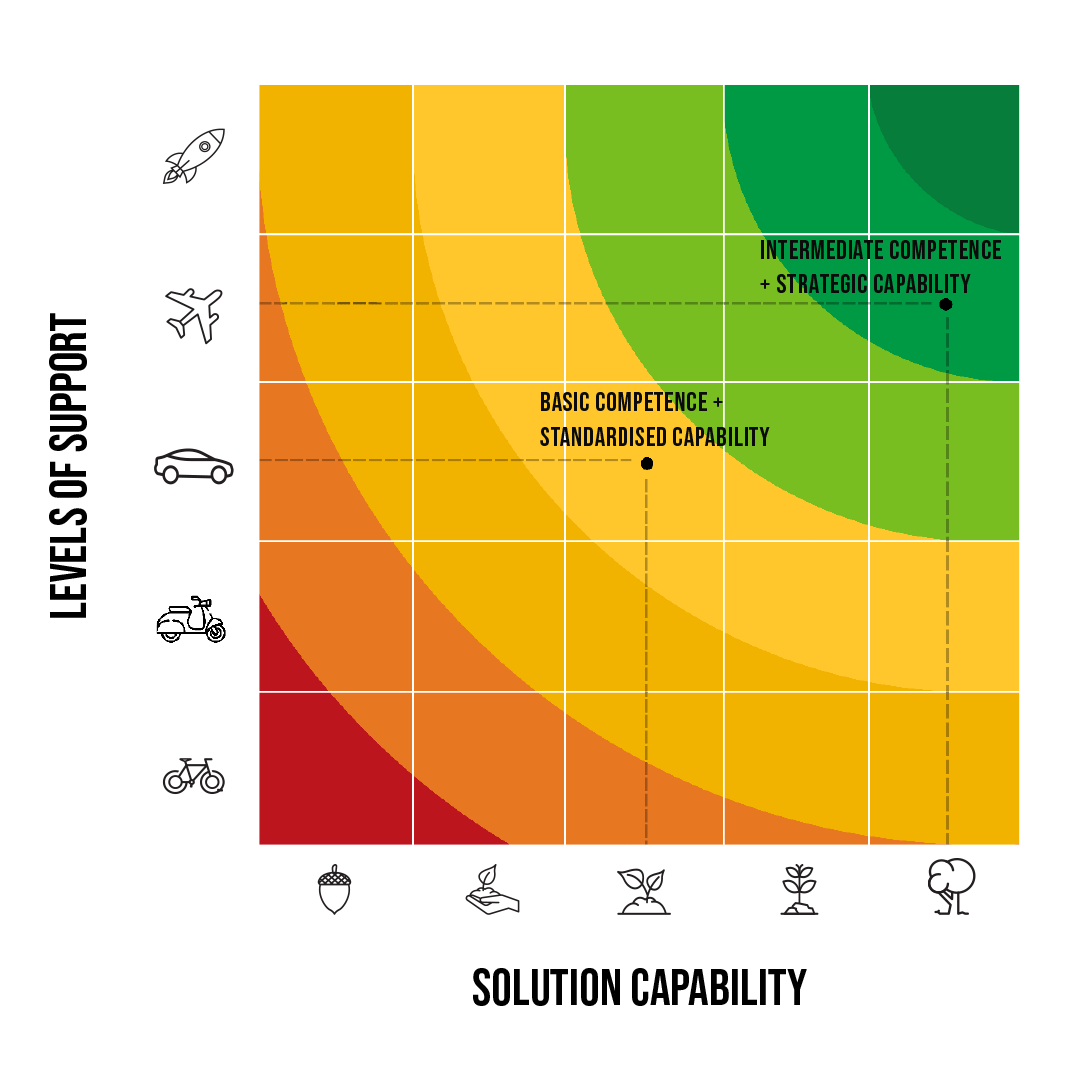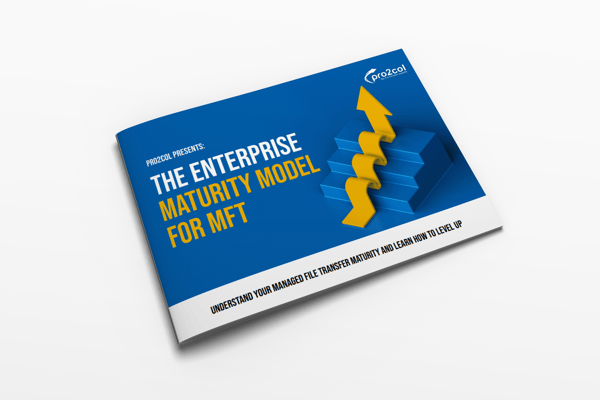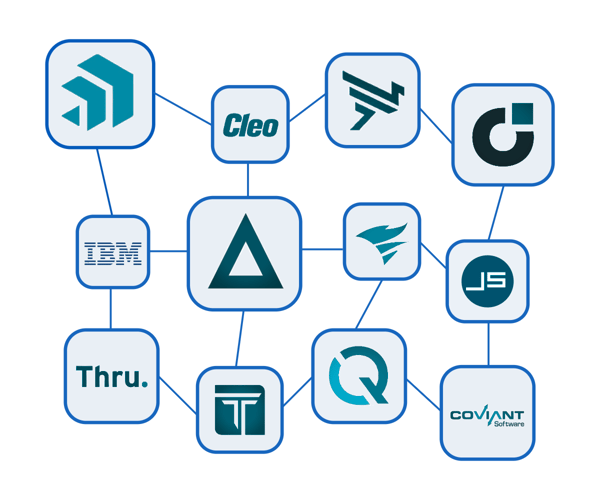The Enterprise Maturity Model for Managed File Transfer (MFT)
Understand your managed file transfer maturity and learn how to level up.
What is The Enterprise Maturity Model for MFT?
The Enterprise Maturity Model for Managed File Transfer (MFT) is a framework designed to help organisations assess, optimise, and future-proof their file transfer infrastructure.
The MFT Maturity Model breaks down your file transfer environment into measurable stages, assessing both the technical capability of your existing MFT solution and your organisation’s ability to support it. Understanding how each stage builds upon the last is key to making strategic decisions that align with long-term business goals. By leveraging our Maturity Model, you'll be able to:
- Plot your current MFT maturity level with confidence
- Identify areas for improvement
- Advance your data transfer technology stack
- Deliver more reliable and secure file transfer services across the enterprise


The Enterprise Maturity Model For MFT
Empower your team to evaluate and upgrade their file transfer systems with the MFT Maturity Model. Benchmark your current infrastructure against industry standards, pinpoint areas for strategic investment, and align your technology with your long-term business goals.
How Does The MFT Maturity Model Work?
1. Identify Your Solution Capability
As your business grows, so should your file transfer capability. What once worked seamlessly may now be struggling to keep up, or you might have invested in a robust solution that remains largely unused. Solution Capability refers to the range of features and functions your file transfer solution offers and how well it meets your organisation’s complexity, scale, and security requirements. It’s not about having the most expensive or advanced solution, it’s about aligning your business needs with the right tool for the job.
This section of the Maturity Model explores the five stages of Solution Capability, helping you pinpoint where your current solution fits within the matrix and what steps to take next.

2. Understand the Levels of Support
In managing your file transfer infrastructure, having the right expertise available is vital. Some organisations rely on a single IT professional with limited experience, making them heavily dependent on vendor support. Others have a dedicated team capable of handling daily operations but still require external help for complex issues. At the most advanced level, businesses either take full ownership of their solution or outsource management to file transfer specialists for expert support.
This section of the MFT Maturity Model breaks down the five levels of support in detail, helping you assess where your organisation stands today and what kind of support structure you’ll need to meet future demands and drive long-term success.

3. Plot Your Position on The Maturity Matrix
Once you've assessed both your Solution Capability and Level of Support, you're ready to plot your organisation’s position on the MFT Maturity Matrix. This visual framework brings both dimensions together, helping you clearly see where your file transfer environment currently stands.
By identifying your current position, you'll gain clarity on your strengths, gaps, and opportunities for growth. Whether you’re operating at a basic level or nearing full maturity, the matrix helps prioritise where to focus your efforts for maximum impact.
If, after reviewing the Maturity Model, you identify a gap between the maturity and support level of your current file transfer solution and your business goals, consulting with Pro2col's team of Managed File Transfer specialists can save you time and money in achieving your long-term objectives.

Why MFT Maturity is Important
File transfer tools are the workhorses of countless businesses, handling massive amounts of data that keep operations and supply chains running smoothly. Understanding your Managed File Transfer (MFT) maturity provides visibility into how well your current infrastructure supports your business.
The objective of this maturity model is to enable technology teams to benchmark their current file transfer infrastructure, identifying strengths, opportunities and providing recommendations on how and when to make further investments, as business requirements mandate. It also provides a benchmark of an organisation's technical capabilities in supporting their solution. In highlighting skill development opportunities, best practices and external support options, enterprises can identify their MFT systems' resilience and secure against evolving threats where needed, helping you maximise ROI and make the most of your file transfer investment.
Benefits of The Maturity Model for MFT
Evaluate & Benchmark
Get a clear, objective view of where your organisation stands in terms of file transfer maturity. This helps you assess the strengths and weaknesses in your existing infrastructure and provides a benchmark for improvement.
Strengthen Your Security Posture
Identify any potential vulnerabilities in your current file transfer solution and deployment, allowing you to proactively address security gaps and strengthen your overall security posture.
Identify Gaps
Easily identify gaps in areas such as security, compliance, or file transfer expertise. Understanding where you are versus where you want to be enables you to prioritise the most critical areas for improvement and target them with precision.
Improve ROI & Planning
Understanding where you are vs where you want to be, allows you to better calculate the ROI from improving your file transfer processes. You can identify the areas that will deliver the most value, making it easier to justify investments in people, technology, or infrastructure.
Managed File Transfer Resources
Frequently Asked Questions
A maturity model is a common tool developed to assist people with their software procurement decisions. Similar to the Gartner quadrant or G2 review scores it provides a system where businesses can plot their operational position and software stack against the rest of the market.
As the global consultancy experts in Managed File Transfer, Pro2col have reviewed the marketplace and leveraged their two decades of experience to develop an Enterprise Maturity Model for Managed File Transfer (MFT). Given the lack of an updated Gartner quadrant this is an overdue tool to bring to market.
The model offers a structured and strategic way to assess and improve your file transfer infrastructure over time. By identifying where your organisation stands within the model, you can uncover weaknesses, streamline operations, and prioritise improvements in areas that are crucial for scaling your business and mitigating risk.
Broken down into two sections, the model provides a five-stage framework to measure the maturity of both your current file transfer infrastructure and your organisation’s ability to technically support it - with recommendations on how improvements can be made to increase your level of proficiency.
The model is designed to be used by anyone who is responsible for ensuring that file transfer processes are secure, scalable and compliant. This includes IT leaders and enterprise architects, security and compliance officers, operations and infrastructure teams, and integration and application teams.
The model is especially valuable for enterprise-level organisations where the volume, complexity, and criticality of file transfers exceed the capacity of ad-hoc tools or unmanaged solutions. It’s particularly relevant to highly-regulated industries including:
- Financial services - where secure data transfer exchanges often contain sensitive customer data or transactional records governed by PCI-DSS, SOX, or DORA.
- Healthcare - where HIPAA compliance mandates secure transfer of electronic protected health information
- Retail - which depends on accurate, real-time exchange of inventory, pricing, and customer data across supply chains and warehouses.
- Government - where sensitive data must comply with frameworks such as GDPR, ensuring secure data transfer between departments, agencies, and contractors.
Realising your current Managed File Transfer (MFT) software solution no longer meets your operational or strategic needs is a key milestone in your maturity journey. Migration to a new solution can feel daunting, but with the right approach, tools, and guidance, it can also be a major opportunity to improve security, scalability, and automation across your business. Here’s our recommendations on how to get started:
1. Understand Your RequirementsRevisit the outcomes of your maturity model assessment. Are you struggling with security, scalability, compliance, or supporting your solution? These insights will help define what your next MFT platform needs to support.
2. Explore MFT Solutions
Our MFT Tools Comparison Page is a great starting point. It offers an in-depth look at the current MFT marketplace from traditional enterprise platforms to modern SaaS-based and hybrid solutions. Our technical experts regularly revisit existing solutions to review updates, upgrades, and new functionalities, while also keeping an eye on emerging solutions, ensuring you always have the most up-to-date information.
3. Consider Cloud-Native and SaaS-Based Solutions
Many organisations are moving away from traditional on-prem tools in favour of cloud-native or SaaS MFT platforms. To explore your options, check out our Best Cloud MFT Tools page, a companion to the MFT Tools Comparison Page, but focused exclusively on SaaS-based solutions. You might also consider using CloudMFT as your hosted solution. It’s designed for organisations looking for a secure, fully-managed MFT platform with minimal operational overhead. CloudMFT offers robust automation, extensive protocol support, and seamless cloud integration, making it a strong fit for modern enterprise needs.
4. Plan Your Migration Strategically
Migrating MFT systems isn't just a lift-and-shift, it involves auditing existing workflows, understanding dependencies, and minimising disruption. To guide you through this, we’ve created a MFT Migration Blog that outlines key considerations to consider before migrating.
Migrating MFT systems, especially in complex, regulated, or high-volume environments can be challenging. If your internal team lacks the time or specific expertise, consider reaching out to Pro2col specialists. Whether you need help with initial planning, integration design, or full end-to-end implementation, our team can guide you through every stage of the migration.
Absolutely! Many enterprises face the challenge of having the right file transfer solution in place but struggle with ongoing management, optimisation, and expertise.
Our team of experts can step in to provide fully managed services, ensuring your solution is well-supported, secure, and continuously optimised. Whether it’s regular monitoring, solution design and implementation, workflow integration, troubleshooting, system updates, audits or staff training, we offer the expertise you need to keep your file transfer processes running smoothly without adding strain to your internal resources. We can also help bridge knowledge gaps and upskill your team with CFTP (Certified File Transfer Professional), so they can take ownership of your solution over time.
For businesses looking to offload infrastructure management, we provide hosting services, ensuring your solution remains secure and reliable.
MFT is an absolute workhorse of a product, underpinning some of the world's largest enterprise operations on a day-to-day basis. In some ways, MFT is often a victim of its own success. Because the product is so reliable and isn't prone to falling over, it can run silently in the background of a tech stack for years without a hitch. We often come across MFT products that haven't been updated in years, but like any software solution, MFT can become vulnerable over time.
Using old versions of software or pushing tools past their comfort zone as a business scales carries inherent risk. Old or poorly maintained (often cheaper) MFT tools often lack the regular updates and patches needed to stay ahead of bad actors. Similarly, poorly managed MFT architecture can collapse when more is demanded of it.
This Maturity Model allows you to align your security and risk appetite with your future plans for your MFT solution, in line with business growth. It helps assess whether the time has come to overhaul your entire system, or whether some strategic TLC and minor upgrades could keep your MFT running smoothly for the next five years.





